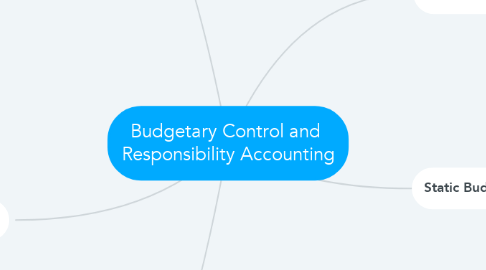
1. Flexible Budgets
1.1. Flexible budget projects budget data for various levels of activity
1.2. Over budget in three of six overhead costs
1.3. Comparison based on budget data for 10,000 units - the original activity level which is not relevant.
1.4. Developing the Flexible Budget
1.4.1. 1: Identify the activity index and the relevant range of activity
1.4.2. 2: Identify the variable costs and determine the budgeted variable cost per unit of activity for each cost.
1.4.3. 3: Identify the fixed costs and determine the budgeted amount for each cost.
1.4.4. 4: Prepare the budget for selected increments of activity within the relevant range.
1.4.5. FC + VC = total budgeted cost
1.5. Flexible Budget Reports
1.5.1. Monthly comparisons
1.5.2. internal report.
1.5.3. Consists of two sections : Production data & cost data
1.5.4. Widely used in production and service departments to evaluate a manager’s performance
2. Responsibility Accounting
2.1. Accumulating and reporting costs (and revenues, where relevant) on the basis of the manager who has the authority to make the day-to-day decisions about the items
2.2. Especially valuable in a decentralized company
2.3. Two differences from budgeting in reporting costs and revenues: 1. Distinguishes between controllable and noncontrollable costs. 2. Emphasizes or includes only items controllable by the individual manager in performance reports.
2.4. Applies to both profit and not-for-profit entities. ► Profit entities: maximize net income. ► Not-for-profit: minimize cost of providing services
2.5. Principles of Performance Evaluations
2.6. Responsibility Reporting System
3. Types of Reponsibility Centers
3.1. Cost center
3.1.1. Based on a manager’s ability to meet budgeted goals for controllable costs
3.1.2. Results in responsibility reports which compare actual controllable costs with flexible budget data
3.2. Profit center
3.2.1. Based on detailed information about both controllable revenues and controllable costs
3.2.2. Manager controls operating revenues earned, such as sales
3.2.3. Manager controls all variable costs incurred by the center because they vary with sales
3.3. Investment center
3.3.1. Return on investment (ROI) is the primary basis for evaluating the performance of a manager of an investment center.
4. Budgetary Control
4.1. use of budgets in controlling operations
4.1.1. Takes place by means of budget reports which compare actual results with planned objectives
4.1.2. Provides management with feedback
4.1.3. Budget reports can be prepared as frequently as needed.
4.1.4. Analyze differences
5. Static Budget Report
5.1. is a projection of budget data at one level of activity
5.2. Uses and Limitations
5.2.1. Appropriate for evaluating a manager’s effectiveness incontrolling costs when:
5.2.1.1. Actual level of activity closely approximates master budget activity level
5.2.1.2. Behavior of costs is fixed in response to changes in activity
5.2.2. Appropriate for fixed costs.
5.2.3. Not appropriate for variable costs
